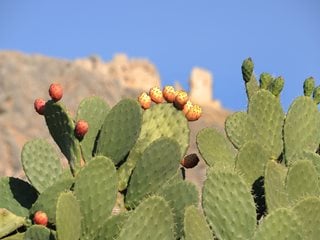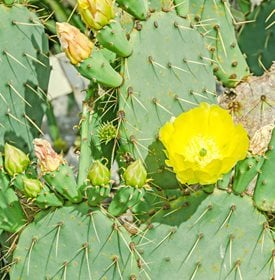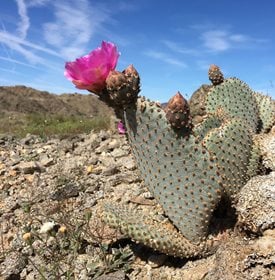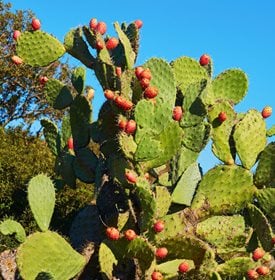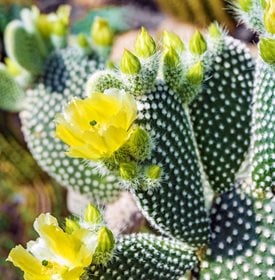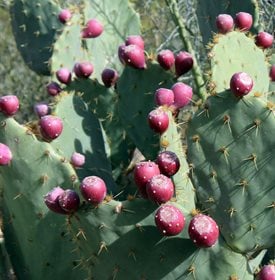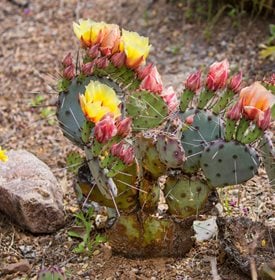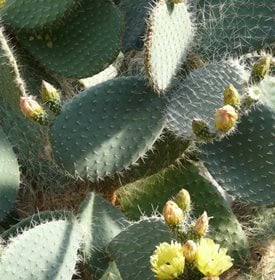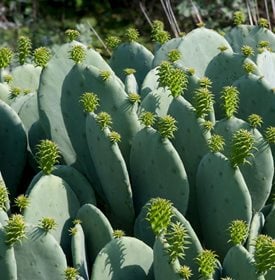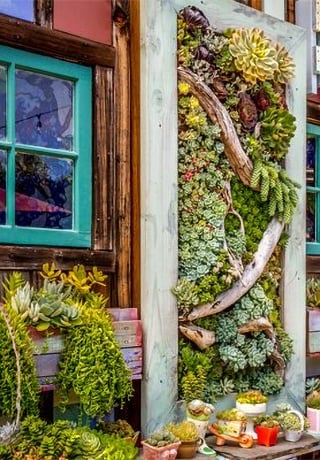GROWING PRICKLY PEAR CACTUS
How to grow and propagate Opuntia in your gardenPrickly pears are a subgroup of Opuntia, identified by their wide, flat, branching pads, and are often called nopal cactus or paddle cactus. Most varieties have a combination of detachable spines and tufts of barbed bristles (glochids) that can cause significant allergic skin reactions. There are also spineless varieties like O. ellisiana and others.
The pads, flowers and fruit of most varieties are edible after careful cleaning. Most prickly pear plants are found in warm, dry climates like the Southwest, although there are some cold-hardy varieties such as the Eastern prickly pear (O. humifusa). As the plants prepare for winter, pads may begin to look shriveled and wilted, but they will green up quickly in spring.
On this page: The Basics | How To Plant | Care | Edible Prickly Pear | Pictures | Design Tips
THE BASICS
Zones:
Generally zones 9-11; some varieties, such as O. humifusa, are cold hardy to zone 4.
Height/Spread:
Varieties range from 6- to 12-inch tall, 18-inch wide low-growing cactus to 10- to 15-foot tall trees.
Exposure:
Full sun
Bloom Time:
June to July
Color:
Prickly pear flower color varies by type, usually yellow, red or purple. Fruit colors can also vary in shades of red, green and yellow-orange.
Other:
Because of their spiny nature, prickly pear cactus are deer resistant.
HOW TO PLANT
When to plant:
Cuttings can be started at any time, but you may have better results if planted in spring or summer. Seeds should be started in late spring.
Where to plant:
Prickly pears need a location that receives full sun with well-draining soil.
How to plant:
Transplant at the same level as they are currently growing; deeper planting may cause them to rot. Handle carefully, not just for your own safety, but the pads can get top-heavy and break off. An extra pair of hands can be valuable because prickly pears can be heavy and awkward to lift and place in the hole.
Other:
Wear thick gloves and heavy long sleeves to guard against being poked by a spine or touching the skin-irritating glochids.
See more on starting from seed or pad cuttings under Propagation.
CARE
Pruning:
It’s not necessary to prune prickly pears, but they can be cut back. Remove individual pads as needed to maintain shape and size. Use tongs to hold the pad and a sharp knife to cut it off at the joint, or line where it connects to the next pad. Pads can be calloused off to be planted elsewhere or shared with friends. See more on propagating below.
Soil:
Prickly pears prefer alkaline to neutral soil. More importantly, however, the soil needs to drain well, as residual moisture or puddling can cause the plant to rot.
Amendments & Fertilizer:
Fertilize young plants with a balanced 10-10-10 fertilizer. For established plants, a 5-10-10 or even 0-10-10 water-soluble fertilizer will promote more flowers and fruit. If you are growing for the pads, use a fertilizer that is high in nitrogen.
Watering:
Prickly pears are extremely drought tolerant. Don’t water newly propagated pads for the first month. After that, water every two to four weeks for the first year — twice a month in summer and once a month other times of the year. In most areas, rainfall will be enough to sustain established plants. Supplement in times of drought with the twice-a-month/once-a-month seasonal schedule.
Propagation:
Initial growth from seed is slow and it may take 3 to 4 years before your plant produces flowers and fruit. The seeds need shade to germinate and should be kept moist until that time.
Propagation from pads is much simpler and yields faster results. Here's how:
- Pads that are at least 6 months old can be cut off by following the pruning instructions above.
- Set the pads out in a dry area with light shade and allow the cut end to form a callus. This prevents the new plant from rotting at the base and can take 2 to 4 weeks in warm, dry weather, longer if it is cool or humid.
- Once fully calloused over, plant pads in a mixture of half soil and half sand at a depth of 1 inch. If planted any deeper, your plant can rot.
- Don’t water it for the first month, as there is enough moisture within the pad to sustain itself.
- Prop it up with rocks or other means of support until roots grow over the next month or so. After a month, there should be enough roots that your plant can stand on its own, but continue the support if it’s still a little wobbly.
- You can water it at this time as well and follow the watering guidelines above, making sure to let it dry out completely in between.
On new plants, flowers and fruit will usually appear by the second or third pad that grows.
Diseases and Pests:
Prickly pears don’t normally suffer from any serious disease or insect problems, although they can be affected by rot if grown with poor drainage.
EDIBLE PRICKLY PEARS
Several types of prickly pears produce pads and fruit that are edible. The edible pads are often referred to as nopales and the fruit is commonly called tuna fruit.
Pads can be harvested any time of year, and up to 6 times per year on fast-growing plants, by following the same instructions for pruning above.
When harvesting pads:
- Don’t remove any more than one-third of the total number of pads to keep your plant healthy and producing more pads.
- For the best flavor, remove them from the plant mid-morning when the acid content within them is at its lowest.
- Use tongs to hold them while cleaning and carefully scrape the pads and peel the fruit to remove all traces of spines and glochids; they can also be roasted to burn them off.
Pads can be eaten raw or cooked. They have a lemony flavor and have a somewhat slimy texture similar to okra when cooked.
The juicy red fruits are ripe when the glochids fall off (usually around September) and should be twisted from the pad to remove, not pulled. The fruits can be eaten raw or cooked and used for jams and jellies.
PICTURES
DESIGN TIPS
- Perfect choice for low-water, cactus, rock or rustic-style gardens.
- Suitable for containers, but they can be quite top-heavy, so choose a sturdy container that won’t tip over.
- In colder climates, plant non-hardy types in containers so they can be moved indoors.
- Consider the mature size of your Opuntia cactus and plant where it won’t grow to interfere with pathways and unsuspecting passersby.
- Use spineless varieties where people or animals might come in contact with them, or simply to get the look and not the poke!
- Plant on sandy slopes or dry prairie areas.
Related:
Agave Plants
Desert Plants for Arid Landscapes
Types of Succulents
